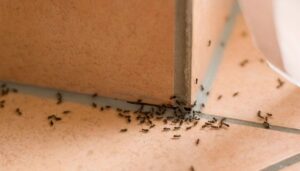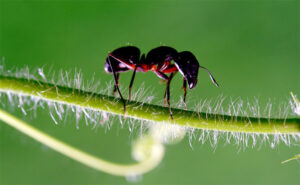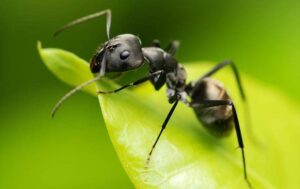A Homeowner’s Guide to Getting Rid of Ants
One of the first insects to become active each year is the irritatingly persistent ant. When warmer weather arrives, ants can begin to march into our homes. Now is the time to start learning how to protect yourself and your home from these intruders.
Identifying the ant
The main source of our ire generally comes from little black ants, pavement ants, odorous house ants and carpenter ants. The little black ant is a whopping one-eighth of an inch long and can be a particular nuisance inside the home as they often are in search of food and water.
Pavement ants can be found in pavement cracks and outside under rocks. These ants often make themselves known after the grass has been watered or after it has rained. Odorous house ants, sometimes referred to as ‘stink ants,’ can be found indoors occasionally foraging for a snack. These tiny guys are most notable for the rotten coconut smell they emit when crushed.
How to tell the difference between an ant and a termite
Because many people associate the presence of wings with termites, flying ants are often misidentified. Ants with wings are just adult ants that are looking to begin a new colony in a different spot. There are a few main differences to look for to differentiate the two. An ant’s antennae are much larger than a termite’s and they bend at just about the halfway point. The waist of an ant is pinched, giving it three visible body segments, while the termite has a broad waist and appears to have only two body segments.
The dos and don’ts of ant elimination
Don’t use Windex or vinegar. I’ve recommended it in the past, but you wouldn’t want to use this in conjunction with baits and other products. This is because we want the ants to follow their trails back to the nest so they can deliver bait to the entire colony.

ANT KILLER: HOW TO GET RID OF ANTS
Ants are one of the most common household pests in the United States. If you see ants in your home, it’s not a sign of a dirty home. It’s simply a sign of ants’ tenacity and survival instincts helping them adapt to the modern age.
KNOW YOUR ENEMY: ALL ABOUT ANTS
Approximately 12,000 species of ants colonize the world, with only a handful of species making a nuisance of themselves in the average home. Ants are social insects, living in large groups called colonies. Most ant colonies have one queen, with thousands of sterile female worker ants. Winged ants are actually males, which are produced when the colony needs more ants. The male ant’s sole purpose in life is to mate with the queen and produce any larvae. One queen ant can live for a year or more and produce millions of offspring during that time.
An ant can lift 20 times its body weight. Ants seek food and water sources, marking their trails using scent chemicals to guide other ants from their colony to a good supply source. Once you see ants inside your home, chances are good that they have set up nearby. Most ants live outdoors and simply find an easy entrance point into a home where food and water are abundant. A few species, such as carpenter ants, nest inside wood and can weaken beams and wooden structures from their tunneling activities.
Ants are often mistaken for termites. Flying ants and termites do look similar from a distance. If you see insects flying around your home, and you aren’t sure if they are termites or ants, try catching one and looking at it under a magnifying glass. Winged ants have a narrow waist and hind wings shorter than the front wings. Termites’ wings are equal in size, and termites tend to shed their wings continually. Many homeowners find termite wings before they actually see termites.
Before reaching for the traps, sprays or natural ant killers, it’s important to make your home as unappealing to ants as possible. Remove tempting food sources. Keep your kitchen and food preparation areas, including the sink and sink trap, as clean as possible. Look around the baseboards, doors and windows to find where the ants are getting into your home, then seal these areas. Most ants prefer to nest outdoors, traveling into homes to seek food.

Ants
What are ants?
Ants are social insects that live together in large groups, working together to maintain the health and safety of their colonies. Ants can be identified by their three distinct body regions: the head, thorax, and abdomen in addition to their antennae. The reproductive members of the colony are winged and emerge from their mature colonies when the weather gets warm in order to mate and create new colonies. Depending on the specific species, ants can range from very small (⅛ of an inch) to quite large (½ to ¾ of an inch) and range in color from black, brown, and red to even yellow.
Are ants dangerous?
The answer to the question of whether or not ants are dangerous is that it depends on the specific species. Many ant species are considered nuisance pests and pose no significant risks to people or property. However, other species have the ability to carry and transmit significant diseases including salmonella and streptococcus and pose health risks to people. Other species of ants, such as carpenter ants, are considered to be dangerous due to the significant structural damages that they can cause to the wood of a home or other structure as they tunnel through it to create their nests.
Why do I have an ant problem?
Ants are typically attracted to properties that offer them easy access to food, shelter and water sources. Properties with clogged gutters, leaky outdoor fixtures, unsecured garbage cans, gardens, and compost piles can easily attract ants. Once these ants are on your property foraging for food and water sources, it won’t be long before they find their way into your home through any small crack or crevice in the foundation or exterior walls of your home. Ants will also invade homes while seeking a temperature-controlled environment to live when the weather outside becomes too hot or too dry for their liking or during periods of heavy rain.
Where do ants nest?
In general, when ants are living outdoors, they can be found nesting in the ground underneath the soil, in piles of wood, in the cracks of pavement, along fence lines, under fallen trees or landscaping ties, or inside tree stumps. Once they find their way inside, ants are typically found nesting underneath floors, behind walls, inside insulation, in crawl spaces, near heating systems, and behind large appliances. In the case of a carpenter ant infestation, you may find them living inside the structural wood of your home or business.
How can I prevent future problems with ants?
Preventing problems with ants can be a difficult task, but there are some steps that homeowners can take to deter them and prevent them from finding their way inside. To help keep ants from invading, seal any gaps found in your home’s foundation, exterior walls, and around the utilities entering into your home. Make sure that all exterior doors have door sweeps installed on them and that all window and door screens are completely intact

Steps to Get Rid of Black House Ants
Dealing with an ant infestation in your home can be difficult to live through. These little black bugs seem to keep popping up no matter how many you kill. What’s worse is the feeling of finding one crawling on you! If you’re like me, you’ll be feeling phantom ants crawling on you the rest of the day.
If you follow good advice, you can tackle your ant problem with a DIY approach and reclaim your house. If you follow bad advice, you could make your ant problem much worse! First we’ll try to identify what kind of ant you’re dealing with and then give you the steps you need to treat the infestation.
What Kind of Ants Do You Have?
Identifying the exact kind of ant species you’re dealing with can be difficult, but isn’t entirely necessary in order to control the outbreak. Still, it can be useful to know what you’re up against.
Here are the three most common types of ants you may be dealing with in your home and how you may be able to tell what they are –
Carpenter ants. Carpenter ants are the most serious type of infestation to have because they can actually cause structural damage to wood over time. Carpenter ants are black or reddish-black, are are the biggest of the ant species we’ll talk about. A carpenter ant is about 1-2″ to 5/8″ long. Carpenter ants can be identified by sawdust you may find and large size. Check out our guide on how to get rid of carpenter ants if you think this is the kind of ant you’re up against.
Little black ants. Little black ants are… very small black ants. Typically just 1-2mm long and a shiny black color.
House ants. House ants (also known as odorous house ants) are small brown/black ants about 1/16-1/8″ in size (roughly twice the size of the little black ant). If you have a REALLY bad infestation, then odds are the house ant is your problem. These ants form multiple colonies, so their population can really explode in a short amount of time. These ants are called “odorous” because they release a bad smell when crushed.
Steps to Get Rid of House Ants
Whether you’re dealing with multiple colonies of ants or just one, the steps to getting them out of your house remains largely the same.
Dealing with Ants
Ants represent a large portion of the insect kingdom. Outdoors they assist in the decomposition of organic matter and help control many insect pests. But indoors, ants quickly become a nuisance. This guide answers common ant questions and includes a glossary of common prevention methods.
Here are some things you can do to reduce your chances of an ant infestation.
Keep trees and shrubs from touching your house. These provide a ready avenue for ants to access the home.
Remove logs and stumps. They are an irresistible housing source.
Fix moisture sources in and around the house.
Seal openings (wiring, plumbing) that allow access from the outside. Applying a bead of caulk or foam sealant is an efficient method of protection.
Keep gutters and downspouts free of leaves.
Clean kitchens after cooking and eating. Cleaning also removes the pheromone trail left by foraging worker ants.
Don’t leave food out. An ant’s idea of a food source is different than humans. A mere crumb can be a feast, so look closely.
Commercial Ant Baits
These are designed to attract foraging ants. When the bait is taken back to the nest, it becomes contaminated. Baits only work if the area they are placed in is clean. Otherwise the ants will continue to feed on “real” food.
Sprays
Sprays provide an immediate knockdown and can help deal with the infestation until the nest or source is eliminated.
Dusts, Powders and Granules
When placed in direct pathways, they are absorbed by ants and brought back to the nests for direct treatment of colonies. Some of these products can be used outdoors as barriers as well.